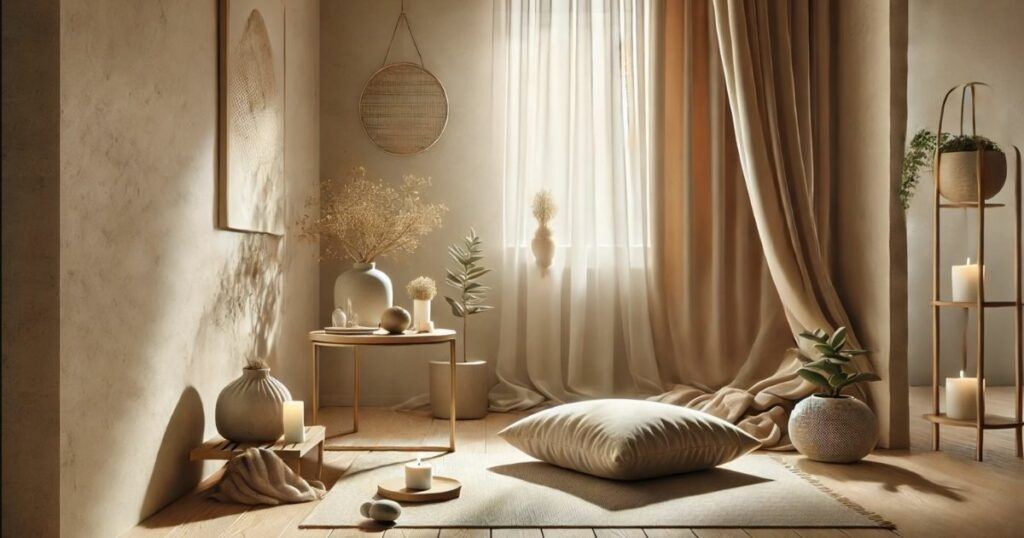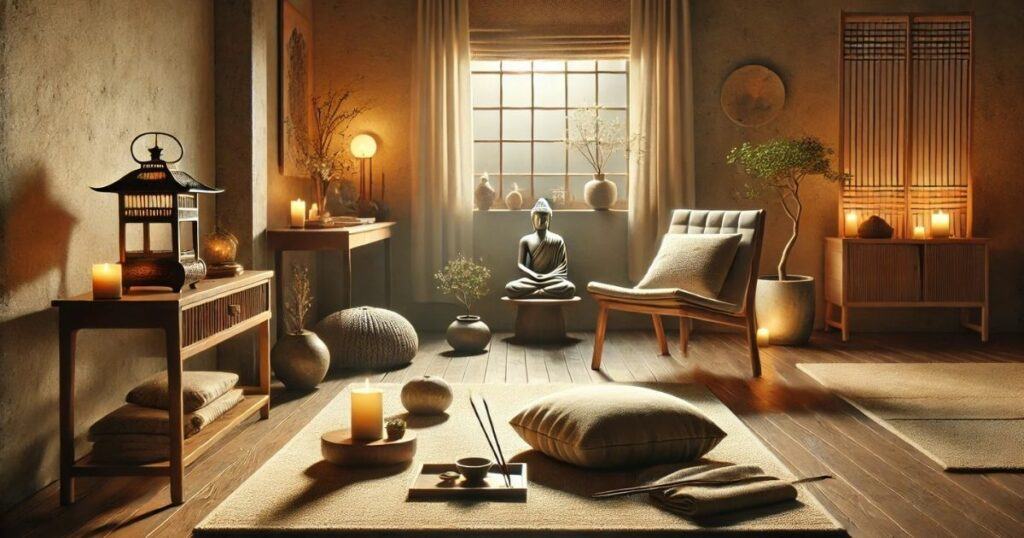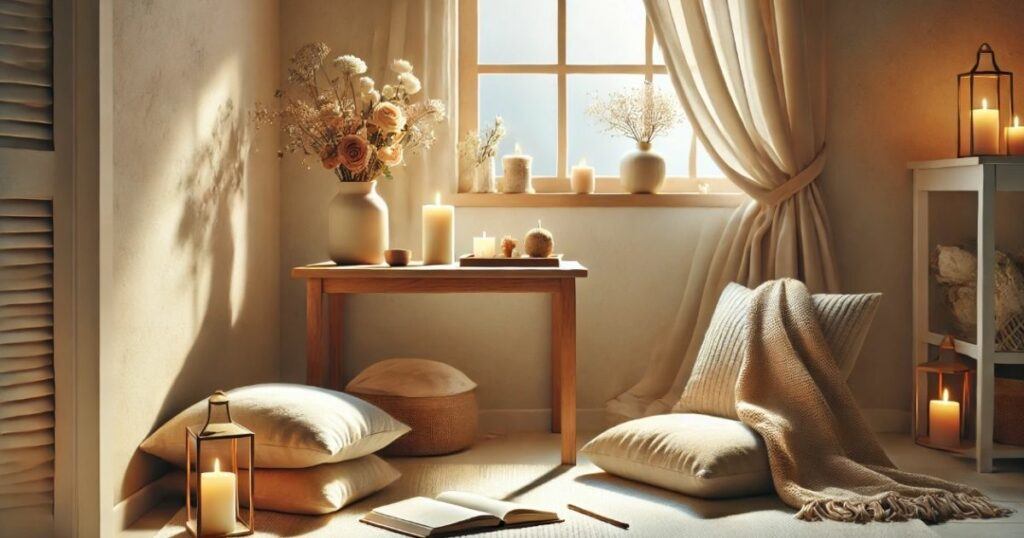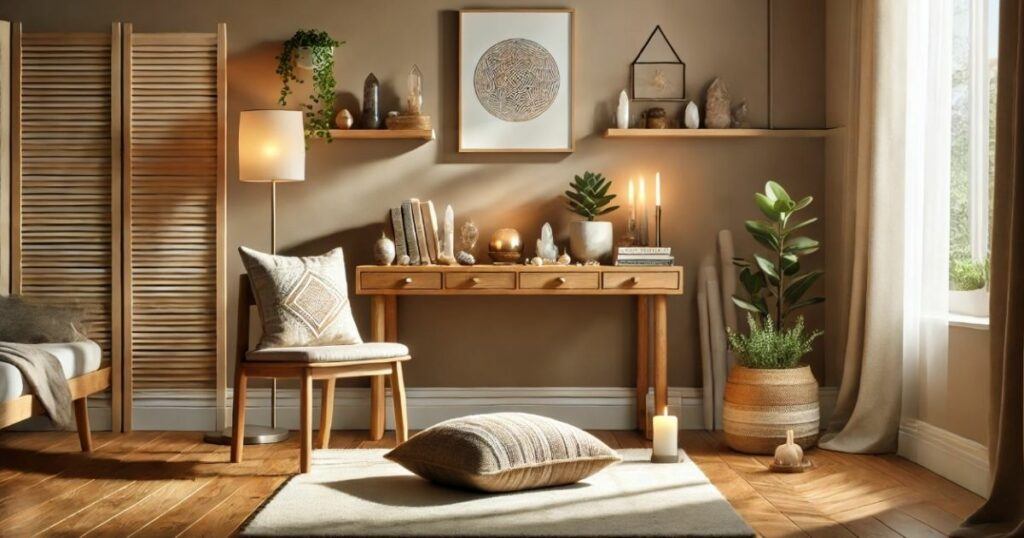
When trying to building a consistent meditation habit, having the right surroundings can be extremely helpful. Creating meditation space that’s calming and free of distractions helps you mentally shift down and more naturally enter a state of mindfulness. It can be used as both a physical and mental anchor, letting it tell you it’s time to slow down and focus inward. In this article, we’ll take a look at how to create a personalized meditation space that feels calming and supportive for you.
A Meditation Space Can Make Or Break You
Your Environment Influences Your Mindset
Have you ever walked into a cluttered room and instantly felt stressed? Our surroundings have a powerful influence on how we feel and behave. Spaces designed for relaxation can improve focus and promote mental well-being. Having a dedicated meditation space can even help create a mental association, or “trigger” between that location and inner peace.
When you sit in your meditation space, your mind will start to recognize that it’s time to quiet down and focus inward. This is not unlike how athletes perform better when they have consistent pre-game rituals—your space becomes part of your own pre-meditation ritual.
Common Challenges Without a Space
If you don’t have a designated space, meditation can feel like a chore rather than an opportunity for peace. Distractions like clutter, loud noises, or the temptation to check your phone can distract your attention away from the present moment. Creating a space can help control these interruptions and make your practice feel more purposeful.
Choosing the Location
Factors to Consider
Choosing the right spot can help create a space that works in your favor. Here are some points to keep in mind:
- Privacy: Choose a spot where you can meditate without interruptions. If you live with others, tell them you need quiet time (respectfully) and establish boundaries.
- Noise levels: While total silence isn’t necessary, a space with low background noise helps you stay focused. White noise, nature sounds, or even quiet music can help if your environment is noisy.
- Natural light: Spaces with access to natural light can improve your mood and help regulate your body’s circadian rhythm. Try to find an area with windows or soft, adjustable lighting.
Ideas for Different Living Situations
You don’t need a lot of space to create a meditation area. Here are some possibilities based on different living situations:
- Small apartments: Use a corner of your bedroom or living room with a floor cushion and a maybe small divider to create separation.
- Multi–purpose rooms: Design a portable meditation setup, such as a mat and candle, that you can store when not in use but easily pull out when ready.
- Larger homes: If you have more room, you might be able dedicate a whole room or set up a spot in your backyard or garden for outdoor meditation.

Some Helpful Items
Items You’ll Need When Creating Meditation Space
Your meditation space should be simple yet comfortable. Start with these important items:
- Comfortable seating: Whether it’s a zafu cushion, meditation bench, or supportive chair, your seat should encourage good posture and be comfortable.
- Floor mat or rug: A mat adds warmth and defines your space. This can help make it feel separate from the rest of your environment.
- Ear buds or headphones: If using binaural beats or a guided meditation, comfortable and dependable era buds or headphones will help deliver the meditation as intended.
Sprucing Up Your Area
Once you have the basics down, add some ambiance your meditation space for a calming and inspiring feeling.
- Lighting: Natural light would be perfect, but if that’s not available, soft, adjustable lighting like a lamp or candles can create a calm/tranquil atmosphere.
- Scent: Many practitioners feel that aromatherapy helps enhance their practice. You can use essential oils or incense, but choose scents that are gentle and not too overpowering — lavender, sandalwood, and frankincense are popular options.
- Sound: If silence isn’t possible, incorporate soft meditation music, white noise , or nature sounds like trickling water, birds or a rainstorm.
Personal Touches to Deepen Your Connection
Adding Meaningful Objects
Personalizing your meditation space helps you own your space. Think about adding items that have an emotional or spiritual significance for you:
- An altar or focal point: This could be a small table with symbolic objects such as a candle, crystal, or plant. Visual focal points can help center your attention during meditation.
- Inspiration nearby: Place an affirmation card, a meaningful quote, or a journal nearby to remind you of your intentions.
Grounding Elements
Bringing nature indoors can create a calming and grounding atmosphere. Research shows that exposure to natural elements helps reduce stress and promotes relaxation. Add:
- Plants: Low-maintenance options like succulents or peace lilies work well.
- Water elements: A small fountain can provide soothing background noise that can help improve your concentration and your meditation experience.
For more on the benefits of indoor plants, you can check out this article on how plants reduce stress and improve well-being.

Your Meditation Space Over Time
Keeping Your Space Clean and Inviting
A cluttered or dusty meditation space can be off-putting. Keep your space distraction free by:
- Regularly picking up and putting away any loose items.
- Dusting, vacuuming, and keeping any fabrics (like cushions or rugs) clean.
- Regularly keeping up with elements like flowers, candles, or focal objects.
Adjusting for Seasonal and Lifestyle Changes
Your meditation space should grow with you as your needs and schedules change. In colder months, you might add a cozy blanket or switch to warm lighting. In warmer weather, opening a window or using light scents can create a refreshing environment. Likewise, if your schedule changes, you’ll need to adjust to fit the new routines.
Tips For Staying Consistent with Your Practice
Creating Rituals Around Your Space
A ritual can make it easier to commit to regular meditation. Try beginning each session with something simple, like lighting a candle or taking a deep cleansing breath. This can help let your mind and body know that it’s time to relax.
Overcoming Resistance
Even with the perfect space, resistance can creep in. To stay consistent:
- Start with small, achievable goals (maybe 3-5 minutes to start with).
- Think about the benefits you’ve experienced. Use a meditation journal to record your thoughts and insights after each session and reflect on this journal often.
Incorporating Journaling
Keeping a journal in your meditation space allows you to capture post-meditation thoughts, reflections or anything else that may come up. If you want to spark some insight, try prompts like this:
- What did I notice during today’s meditation?
- How did my body and mind feel before and after?
Common Mistakes to Avoid
- Overcomplicating your setup: You don’t need an expensive or Instagram-worthy space. Focus on simplicity and comfort.
- Expecting perfection: Meditation spaces are meant to support your practice, not define it. It’s okay if the space isn’t always perfect.
- Neglecting upkeep: Letting clutter build up or failing to maintain your space can reduce its effectiveness over time. This could cause you to resent it.
Creating a meditation space is a powerful way to build and create a lasting habit. It’s an act of self-care that is an anchor for peace and mindfulness in your daily activities. Whether you have a small corner or an entire room, you can create a space that feels meaningful and rejuvenating.

Frequently Asked Questions About Creating a Meditation Space
Creating a meditation space can bring peace and stability to your practice, but many people may still have questions about how to get started. Below are some of the most common questions about setting up a calming and supportive environment for meditation. Hope you find your answer!
1. How to create your own meditation space?
Find a location where you can relax without distractions. Add comfortable seating, such as a cushion or bench, and define the area with a floor mat or rug. From there, build the atmosphere with soft lighting, calming scents, and personal touches like plants or meaningful objects. Keep the space simple to avoid sensory overload and clutter.
2. How to set up a meditation spot?
Setting up a meditation spot involves preparing a small area in your home that will be inviting and peaceful. First, clear the area of clutter. Use a comfortable cushion or chair as the focal point, then add soft lighting like candles or lamps. You can also use grounding elements like natural sounds, a diffuser with essential oils, or an altar with symbolic objects to anchor your practice. The goal is to create a space that encourages you to come back every day.
3. How do you make a sacred space for meditation?
To make a sacred space for meditation, begin by identifying items that carry personal or spiritual significance to you. This might be crystals, a statue, a photograph, or a meaningful piece of art. Place these objects thoughtfully on a small table or shelf. You may also incorporate rituals, such as lighting a candle or reciting an intention or affirmation before each session. The combination of intention and symbolism can help transform your space into a sacred sanctuary.
4. How do you create a Zen space?
A Zen space involves a minimalist environment that encourages relaxation and mindfulness. Start by removing clutter and keeping only essential items that promote peace and the intentions you want. Use natural materials, such as wood and stone, and include elements of nature like plants or a small water feature. Keep colors neutral and calming like soft whites, beige, and earth tones. Finally, make sure your space is free of distractions by keeping technology and noise to a minimum if not totally away.
5. What is a meditation space called?
A meditation space can be called many things depending on its purpose and context. Common terms might be “meditation corner,” “sacred space,” or “Zen den.” It may also be referred to as an altar space or a shrine where these include symbolic objects. Regardless of what it’s called, the goal is to create a calming environment dedicated to introspection and mindfulness.
I hope these answers helped you better understand how to and why creating meditation space is so important! Do you have a favorite spot at home where you like to relax or meditate? What’s one feature you’d include in your ideal meditation space? Let me know in the comments — I’d love to hear! Drop your thoughts in the comments below and thank you for reading!





